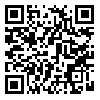Tue, Dec 23, 2025
[Archive]
Volume 14, Issue 41 (2021)
JMED 2021, 14(41): 33-41 |
Back to browse issues page
Download citation:
BibTeX | RIS | EndNote | Medlars | ProCite | Reference Manager | RefWorks
Send citation to:



BibTeX | RIS | EndNote | Medlars | ProCite | Reference Manager | RefWorks
Send citation to:
Moradi S, Akhlaghi A, Valipour Khajegheyasi R, Sadeghimahalli F, Pashaei S M, Tehrani M, et al . The medical school faculty members' opinions examination on whether the curriculum material corresponds to the anticipated positions of general practitioners in Iran. JMED 2021; 14 (41) :33-41
URL: http://edujournal.zums.ac.ir/article-1-1313-en.html
URL: http://edujournal.zums.ac.ir/article-1-1313-en.html
Siavash Moradi1  , Arash Akhlaghi1
, Arash Akhlaghi1  , Roghayeh Valipour Khajegheyasi2
, Roghayeh Valipour Khajegheyasi2  , Forouzan Sadeghimahalli1
, Forouzan Sadeghimahalli1  , Seyedeh Masoumeh Pashaei3
, Seyedeh Masoumeh Pashaei3  , Mohsen Tehrani4, Seyed Mohammad Mehdi Ghaffari Hamedani5
, Mohsen Tehrani4, Seyed Mohammad Mehdi Ghaffari Hamedani5  , Touraj Assadi3
, Touraj Assadi3  , Maryam Sefidgarnia6
, Maryam Sefidgarnia6  , Fattane Amuei *7
, Fattane Amuei *7 
 , Arash Akhlaghi1
, Arash Akhlaghi1  , Roghayeh Valipour Khajegheyasi2
, Roghayeh Valipour Khajegheyasi2  , Forouzan Sadeghimahalli1
, Forouzan Sadeghimahalli1  , Seyedeh Masoumeh Pashaei3
, Seyedeh Masoumeh Pashaei3  , Mohsen Tehrani4, Seyed Mohammad Mehdi Ghaffari Hamedani5
, Mohsen Tehrani4, Seyed Mohammad Mehdi Ghaffari Hamedani5  , Touraj Assadi3
, Touraj Assadi3  , Maryam Sefidgarnia6
, Maryam Sefidgarnia6  , Fattane Amuei *7
, Fattane Amuei *7 
1- Department of Educational Development Center, Mazandaran University of Medical Sciences, Sari, Iran
2- Department of Nursing, Mazandaran University of Medical Sciences, Sari, Iran
3- Department of Emergency Medicine, School of Medicine, Mazandaran University of Medical Sciences, Sari, Iran
4- Department of Immunology, School of Medicine, Gastrointestinal Cancer Research Center Cancer Research Institute,Mazandaran University of Medical Science, Sari, Iran
5- Department of Surgery, School of Medicine, Mazandaran University of Medical Science, Sari, Iran
6- Department of Neurology, Psychiatry and Behavioral Sciences Research Center Addiction Research Institutes, School of Medicine, Mazandaran University of Medical Sciences. Sari, Iran
7- Department of Education Development of Center, Mazandaran University of Medical Sciences, Sari, Iran ,fattane_amuei@yahoo.com
2- Department of Nursing, Mazandaran University of Medical Sciences, Sari, Iran
3- Department of Emergency Medicine, School of Medicine, Mazandaran University of Medical Sciences, Sari, Iran
4- Department of Immunology, School of Medicine, Gastrointestinal Cancer Research Center Cancer Research Institute,Mazandaran University of Medical Science, Sari, Iran
5- Department of Surgery, School of Medicine, Mazandaran University of Medical Science, Sari, Iran
6- Department of Neurology, Psychiatry and Behavioral Sciences Research Center Addiction Research Institutes, School of Medicine, Mazandaran University of Medical Sciences. Sari, Iran
7- Department of Education Development of Center, Mazandaran University of Medical Sciences, Sari, Iran ,
Abstract: (5878 Views)
Background and aim: The complexities of clinical medicine, the advancement of knowledge and experience in medical education, advances in information technology, changes in the delivery of health services, Both of these considerations must be addressed, as well as the need to adjust the curriculum in order to meet the expected capabilities of general practitioners. The aim of this study was to look into the quality of basic and clinical curriculum education, as well as the compatibility of the new curriculum's content with the general practitioner's expected roles.
Methods: A qualitative review (focused community discussion) was performed in 2018 and 2019. In-depth group interviews with medical education experts and selected talented students were conducted to gather data, and classes and themes were extracted using the Granheim and Lundman content analysis method.
Results: Based on the similarity and appropriateness of the results, two groups of 15 codes were identified in the study: adjusting the length of basic sciences and clinical introductory courses, and changing the educational quality of basic sciences and clinical introductions and three categories in the content of clinical education instruction, namely enriching clinical goals With 12 codes, general medicine, content enhancement and organization, and clinical content implementation improvement were established.
Conclusion: Reviewing basic sciences courses with a longitudinal incorporation approach to clinical content, paying attention to the fundamentals of physiopathological reasoning of diseases in clinical planning, and designing an internship strategy focused on clinical reasoning and attending to skills training during the internship course can be beneficial Medical students' educational instruments should be suitable for the anticipated plans and tasks.
Methods: A qualitative review (focused community discussion) was performed in 2018 and 2019. In-depth group interviews with medical education experts and selected talented students were conducted to gather data, and classes and themes were extracted using the Granheim and Lundman content analysis method.
Results: Based on the similarity and appropriateness of the results, two groups of 15 codes were identified in the study: adjusting the length of basic sciences and clinical introductory courses, and changing the educational quality of basic sciences and clinical introductions and three categories in the content of clinical education instruction, namely enriching clinical goals With 12 codes, general medicine, content enhancement and organization, and clinical content implementation improvement were established.
Conclusion: Reviewing basic sciences courses with a longitudinal incorporation approach to clinical content, paying attention to the fundamentals of physiopathological reasoning of diseases in clinical planning, and designing an internship strategy focused on clinical reasoning and attending to skills training during the internship course can be beneficial Medical students' educational instruments should be suitable for the anticipated plans and tasks.
Article Type : Orginal Research |
Received: 2020/04/29 | Accepted: 2021/04/27 | Published: 2021/06/14
Received: 2020/04/29 | Accepted: 2021/04/27 | Published: 2021/06/14
Send email to the article author
| Rights and permissions | |
 |
This work is licensed under a Creative Commons Attribution-NonCommercial 4.0 International License. |




